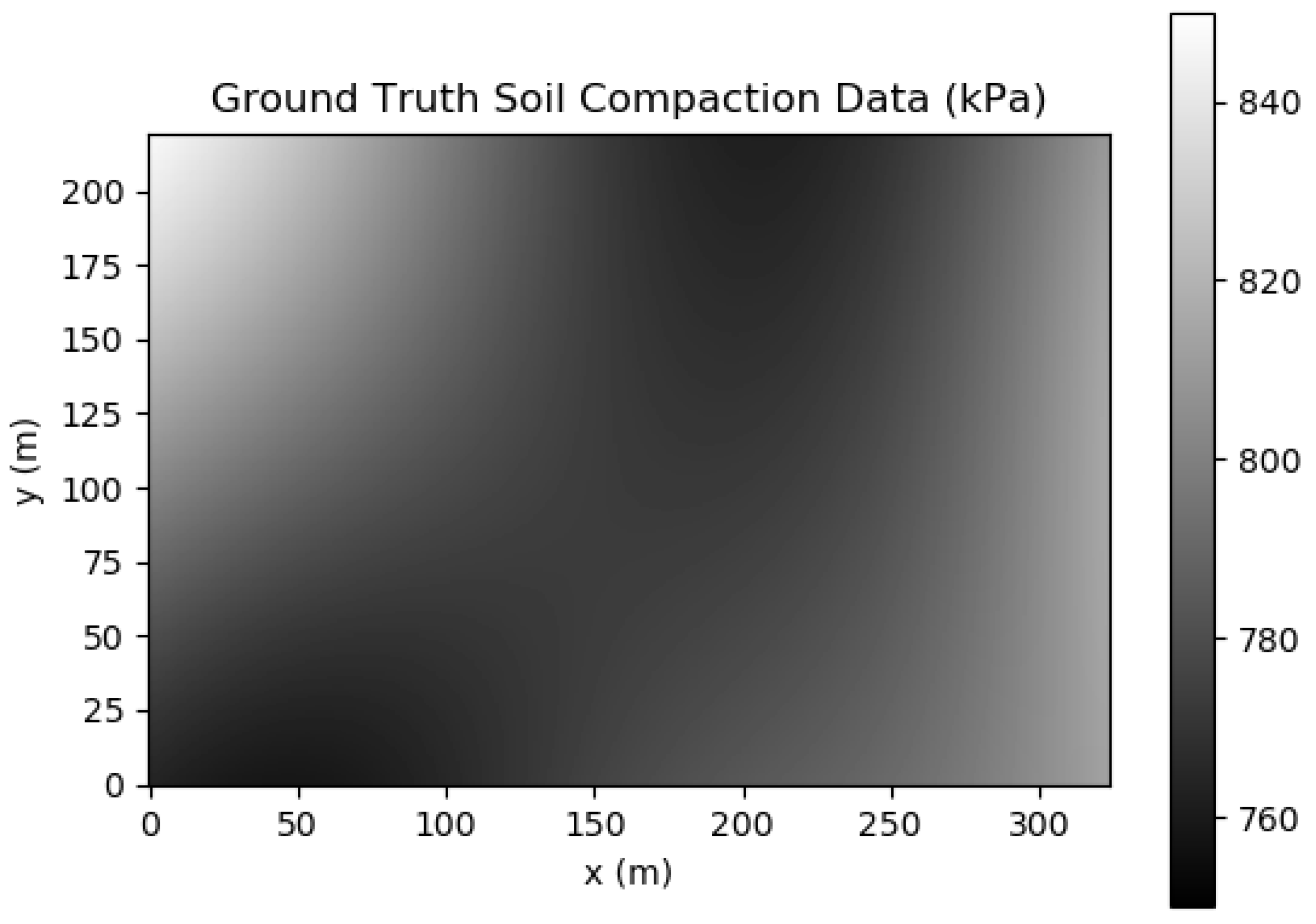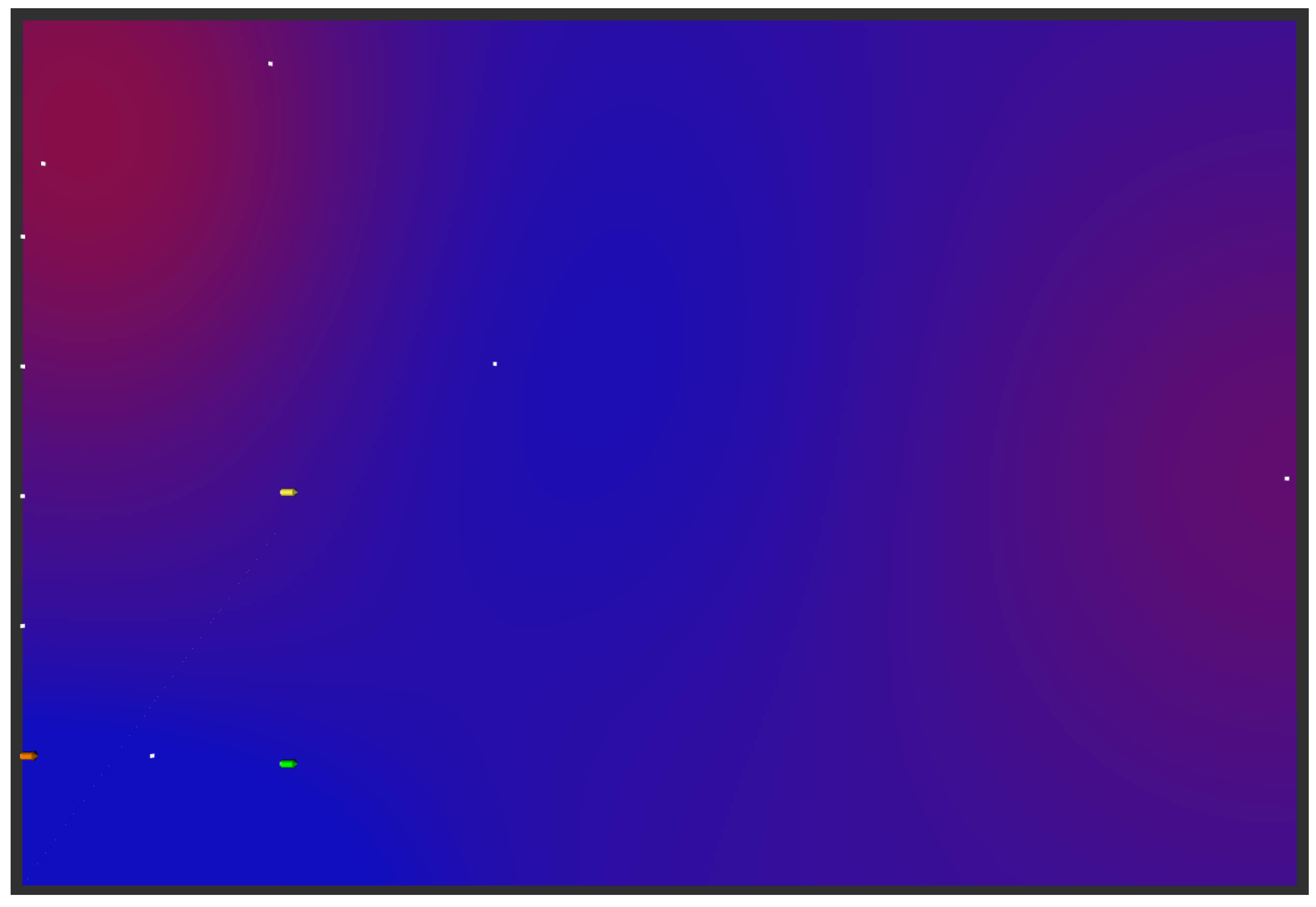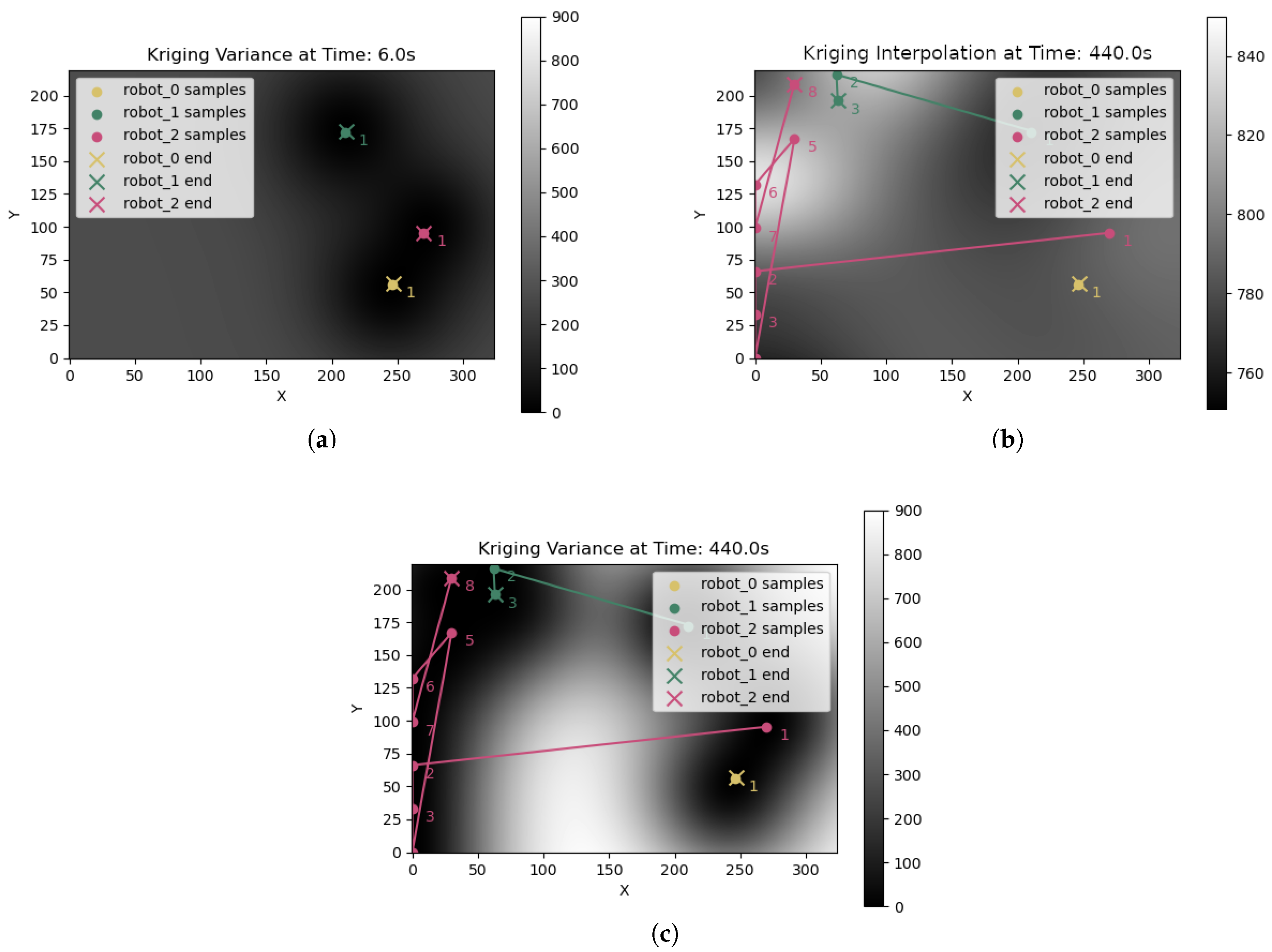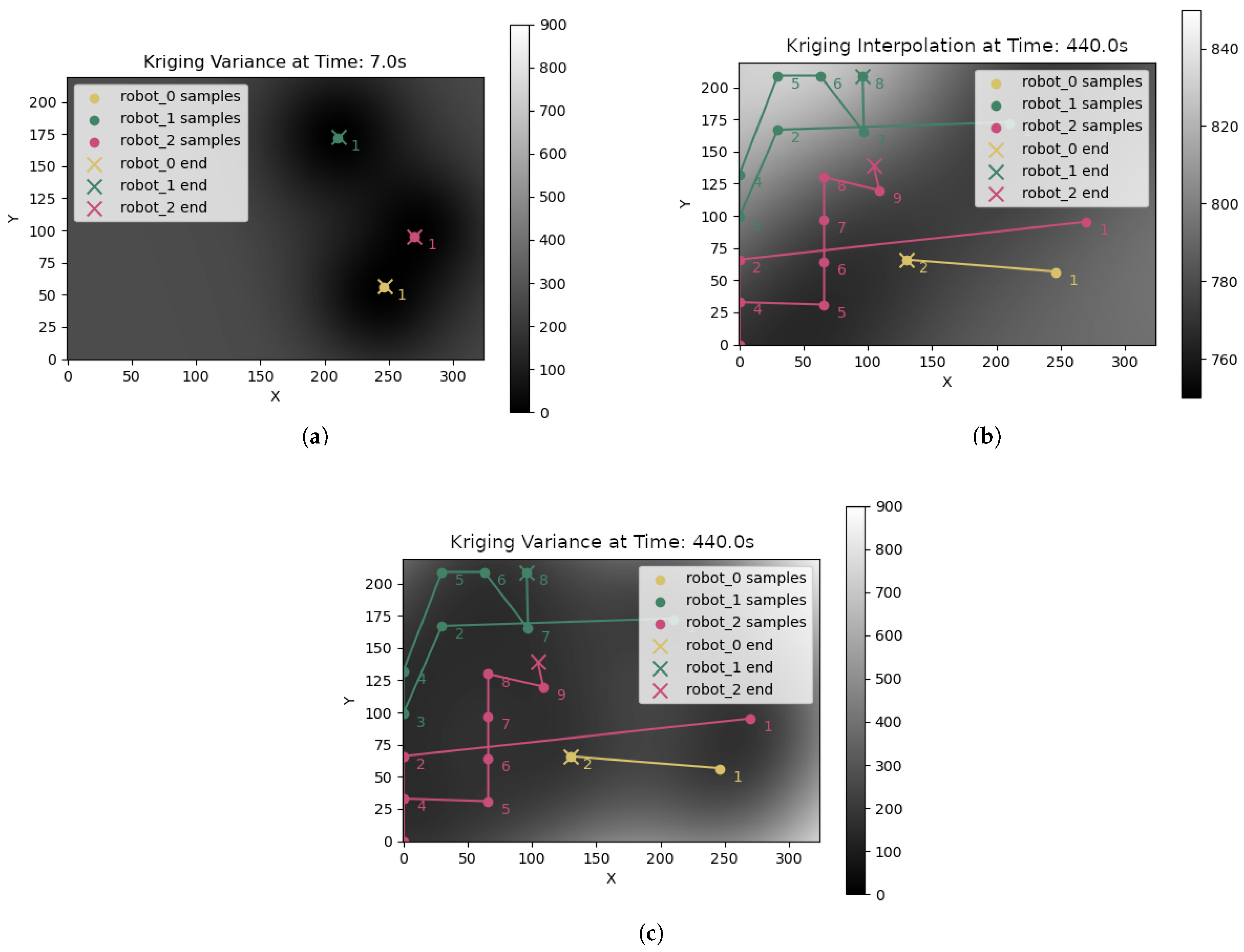Kriging-Variance-Informed Multi-Robot Path Planning and Task Allocation for Efficient Mapping of Soil Properties
Abstract
1. Introduction
- DOV (Distance Over Variance)—A Kriging-variance-informed bid calculation for auction-based MRTA.
- Integration of the DOV bid calculation into the cheapest insertion heuristic [18].
- Thresholding of tasks at low Kriging variance locations at the point of task creation.
2. Related Work
2.1. Automated Soil Properties Mapping
2.1.1. Aerial Sensing
2.1.2. Wireless Sensor Networks
| Reference | Key Contribution and Description |
|---|---|
| Fentanes et al. [14] (2018) | Demonstrated 3D soil compaction mapping using the Thorvald outdoor mobile robot [16]. Used Ordinary Kriging (OK) interpolation to predict measurements at unsampled locations and OK variance to direct a single robot (Thorvald) with a bespoke automated penetrometer to sample the location with the highest Kriging variance, informing its path planning. |
| Fentanes et al. [30] (2020) | Presented an informative path planning (IPP) method based on Kriging variance for single-robot soil moisture mapping. The robot navigates to the location with the highest uncertainty (Kriging variance) after each new measurement and interpolation. This greedy Next Best View (NBV) adaptive sampling method is extended in the current work to multiple robots by creating sampling tasks at the highest Kriging variance locations. |
| Roberts-Elliott et al. [17] (2022) | Extended the IPP approach described in [30] to multiple robots, generating new sampling tasks after each new measured sample and subsequent interpolation. |
| Schneider et al. [9] (2015) | Evaluated auction-based multi-robot task allocation (MRTA) algorithms for dynamic task environments, finding Sequential Single-Item (SSI) auction to be effective. Dynamic task environments are characteristic of informative path planning where tasks are not known beforehand and new tasks are created continuously. The current work compares against and extends the SSI auction approach. |
| Rosenkrantz et al. [18] (1977) | Proposed the cheapest insertion heuristic, which is implemented as an optional feature in the current work’s coordinator for use in calculating the bid function and the insertion index of tasks added to robots’ task queues. This heuristic calculates the cost of a robot traversing its task queue when a new task is inserted at different indices, selecting the insertion that results in the lowest cost increase. The current work integrates its bespoke DOV bid function into this heuristic. |
2.1.3. Ground-Based Robotic Solutions
2.2. Informative Path Planning
2.3. Multi-Robot Coordination
3. Methodology
3.1. Multi-Robot Informative Path Planning from Kriging Variance
3.2. Bid Calculation for Allocation of Soil Sampling Tasks
3.2.1. Distance over Variance (DOV) Bid Function for Auction-Based Multi-Robot Task Allocation
3.2.2. Cheapest Insertion Heuristic
3.3. Abstract ROS Simulation of Multi-Robot Soil Compaction Mapping
4. Experimental Design
- ED—Euclidean distance as the bid value.
- EDCI—Euclidean distance as the bid value with the cheapest insertion heuristic.
- EDTD—Euclidean distance as the bid value with task dropping.
- EDCITD—Euclidean distance as the bid value with the cheapest insertion heuristic and task dropping.
- DOV—Distance Over Variance as the bid value.
- DOVCI—Distance Over Variance as the bid value with the cheapest insertion heuristic.
- DOVTD—Distance Over Variance as the bid value with task dropping.
- DOVCITD—Distance Over Variance as the bid value with the cheapest insertion heuristic and task dropping.
- Kriging RMSE (Root Mean Squared Error) (↓)—The RMSE between the Kriging interpolation of soil compaction produced from the samples taken by the multi-robot sampling, and the ground truth soil compaction data. A lower value indicates a more accurate interpolation.
- Max task queue length (↓)—The maximum length measured across all of the robots’ task queues. A lower value indicates more efficient task allocation, as task positions are reached and tasks are executed more quickly, avoiding a large backlog of queued tasks.
- Mean TA (task allocation) equality (↑)—A metric that measures how equally distributed tasks are between the robot team. This equality E is calculated using the equal allocation proportionwhere is the number of robots. With this, we can calculatewhere T is the set of task counts for all robots (please note that is used to denote the cardinality of T, to distinguish it from the notation for absolute distance), indexed by robot ID r, and i is the ID of the robot we are calculating the TA equality for.This TA equality is calculated for each robot, and the mean is taken to represent the equality of TA for the whole team. Values closer to 1 indicate more equal task allocation, and values closer to 0 show a less equal task allocation.
- Mean Kriging variance (↓)—The mean of the Kriging variance matrix generated from the most recent Kriging interpolation. Lower values indicate less overall uncertainty in the estimates of the interpolation.
- Mean task completion time (seconds) (↓)—The mean time taken to execute a sampling task, across all robots and tasks, measured from the beginning of robot navigation towards the task, to task completion following the measurement of the task’s sample. Lower values indicate more efficient task allocation, with robots allocated tasks they are capable of completing in a shorter time.
- Number of samples (↑)—The total number of samples of soil compaction measured by the robot team. A high value is considered to be the best value, as the trials are run for a specific time. If the trials are run for an arbitrary time until the Kriging variance comes below a threshold value, a low value would be ideal for this metric.
- Total distance travelled (metres) (↓)—The total distance travelled by the robot team, measured in metres. A lower value is preferred as complete coverage of the environment is not desired, but rather a time-efficient exploration and mapping of the soil property distribution from sampling “hot spots” that provide high information gain. This metric is also a proxy for the energy expenditure and soil compaction contribution of the multi-robot system, and so a lower total distance corresponds to reduced energy requirements and environmental impacts.
- Total idle time (seconds) (↓)—The total time that robots within the team have spent idle (stationary, without any current or queued tasks). A low value is considered to be the best here, assuming maximum utilisation. However, if the number of samples is smaller for the same number of robots, the idle time can be high.
- Total robot tasks count—The total number of sampling tasks allocated to the robot team. A lower or higher value may be preferable depending on whether tasks are being executed efficiently. This should be viewed in conjunction with the maximum task queue length, as a high total task count in combination with a high maximum task queue length indicates that more tasks are being created than the robots can complete before being allocated subsequent tasks.
- Earliest Time Where RMSE < 0.75 × STD (seconds) (↓)—The earliest time in the sampling mission where Kriging RMSE is less than of the standard deviation (STD) of the ground truth soil compaction data. This serves as an optimisation indicator for the mapping, as the RMSE of predictions being significantly below the STD of the ground truth demonstrates that the model captures the variability of the data it is estimating [37,38]. Lower values in this metric indicate an earlier acquisition of an accurate soil property map, and thus a more time-efficient mapping.
5. Simulated Experiment Results
6. Conclusions
Author Contributions
Funding
Institutional Review Board Statement
Data Availability Statement
Conflicts of Interest
References
- McGrath, J.M.; Spargo, J.; Penn, C.J. Soil Fertility and Plant Nutrition. In Plant Health; Elsevier: Amsterdam, The Netherlands, 2014; pp. 166–184. [Google Scholar] [CrossRef]
- Storm, H.; Seidel, S.J.; Klingbeil, L.; Ewert, F.; Vereecken, H.; Amelung, W.; Behnke, S.; Bennewitz, M.; Börner, J.; Döring, T.; et al. Research priorities to leverage smart digital technologies for sustainable crop production. Eur. J. Agron. 2024, 156, 127178. [Google Scholar] [CrossRef]
- Robert, P. Characterization of soil conditions at the field level for soil specific management. Geoderma 1993, 60, 57–72. [Google Scholar] [CrossRef]
- United States of America. Department of Agriculture. Environmental Quality Incentives Program. 2024. Available online: https://www.nrcs.usda.gov/programs-initiatives/eqip-environmental-quality-incentives (accessed on 28 May 2025).
- European Commision. Healthy Soil. 2023. Available online: https://agriculture.ec.europa.eu/sustainability/environmentalsustainability/natural-resources/soil_en (accessed on 15 September 2024).
- Great Britain. Department for Environment, Food & Rural Affairs. SFI Scheme Information: Expanded Offer for 2024. 2024. Available online: https://www.gov.uk/government/publications/sustainable-farming-incentive-scheme-expanded-offer-for-2024/sfi-scheme-information-expanded-offer-for-2024 (accessed on 28 May 2025).
- Fentanes, J.P. Soil Compaction Dataset. 2018. Available online: https://figshare.com/projects/Soil_Compaction_Dataset/31418 (accessed on 28 May 2025).
- Quinton, F.; Grand, C.; Lesire, C. Market Approaches to the Multi-Robot Task Allocation Problem: A Survey. J. Intell. Robot. Syst. 2023, 107, 29. [Google Scholar] [CrossRef]
- Schneider, E.; Sklar, E.I.; Parsons, S.; Özgelen, A.T. Auction-Based Task Allocation for Multi-robot Teams in Dynamic Environments. In Proceedings of the Conference Towards Autonomous Robotic Systems, Liverpool, UK, 8–10 September 2015; Dixon, C., Tuyls, K., Eds.; Lecture Notes in Computer Science. Springer: Cham, Switerland, 2015; pp. 246–257. [Google Scholar] [CrossRef]
- Weiler, M.; McDonnell, J.J. Soil development and properties|water storage and movement. In Encyclopedia of Forest Sciences; Burley, J., Ed.; Elsevier: Oxford, UK, 2004; pp. 1253–1260. [Google Scholar] [CrossRef]
- Jorajuria, D.; Draghi, L.; Aragon, A. The effect of vehicle weight on the distribution of compaction with depth and the yield of Lolium/Trifolium grassland. Soil Tillage Res. 1997, 41, 1–12. [Google Scholar] [CrossRef]
- Brevik, E.; Fenton, T.; Moran, L. Effect of soil compaction on organic carbon amounts and distribution, South-Central Iowa. Environ. Pollut. 2002, 116, S137–S141. [Google Scholar] [CrossRef]
- Chamen, W.C.T.; Vermeulen, G.D.; Campbell, D.J.; Sommer, C. Reduction of traffic-induced soil compaction: A synthesis. Soil Tillage Res. 1992, 24, 303–318. [Google Scholar] [CrossRef]
- Fentanes, J.P.; Gould, I.; Duckett, T.; Pearson, S.; Cielniak, G. 3D Soil Compaction Mapping through Kriging-based Exploration with a Mobile Robot. arXiv 2018, arXiv:1803.08069. [Google Scholar]
- Oliver, M.A.; Webster, R. Kriging: A method of interpolation for geographical information systems. Int. J. Geogr. Inf. Syst. 1990, 4, 313–332. [Google Scholar] [CrossRef]
- Grimstad, L.; From, P.J. Thorvald II—A Modular and Re-configurable Agricultural Robot. IFAC-PapersOnLine 2017, 50, 4588–4593. [Google Scholar] [CrossRef]
- Roberts-Elliott, L.; Millard, A.G.; Das, G.P. Agent-Based Simulation of Multi-Robot Soil Compaction Mapping. In Towards Autonomous Robotic Systems; Proceedings of the Lecture Notes in Computer Science; Springer: Oxford, UK, 2022; p. 15. [Google Scholar]
- Rosenkrantz, D.J.; Stearns, R.E.; Lewis, P.M., II. An Analysis of Several Heuristics for the Traveling Salesman Problem. SIAM J. Comput. 1977, 6, 563–581. [Google Scholar] [CrossRef]
- Copernicus. Discover Our Satellites. 2021. Available online: https://www.copernicus.eu/en/about-copernicus/infrastructure-overview/discover-our-satellites (accessed on 28 May 2025).
- Bendig, J.; Bolten, A.; Bennertz, S.; Broscheit, J.; Eichfuss, S.; Bareth, G. Estimating Biomass of Barley Using Crop Surface Models (CSMs) Derived from UAV-Based RGB Imaging. Remote Sens. 2014, 6, 10395–10412. [Google Scholar] [CrossRef]
- Costa, L.; Nunes, L.; Ampatzidis, Y. A new visible band index (vNDVI) for estimating NDVI values on RGB images utilizing genetic algorithms. Comput. Electron. Agric. 2020, 172, 105334. [Google Scholar] [CrossRef]
- Yuzugullu, O.; Lorenz, F.; Fröhlich, P.; Liebisch, F. Understanding Fields by Remote Sensing: Soil Zoning and Property Mapping. Remote Sens. 2020, 12, 1116. [Google Scholar] [CrossRef]
- Ge, X.; Wang, J.; Ding, J.; Cao, X.; Zhang, Z.; Liu, J.; Li, X. Combining UAV-based hyperspectral imagery and machine learning algorithms for soil moisture content monitoring. PeerJ 2019, 7, e6926. [Google Scholar] [CrossRef]
- Das, K.; Paul, P.K. Present status of soil moisture estimation by microwave remote sensing. Cogent Geosci. 2015, 1, 1084669. [Google Scholar] [CrossRef]
- Ivushkin, K.; Bartholomeus, H.; Bregt, A.K.; Pulatov, A.; Franceschini, M.H.D.; Kramer, H.; van Loo, E.N.; Jaramillo Roman, V.; Finkers, R. UAV based soil salinity assessment of cropland. Geoderma 2019, 338, 502–512. [Google Scholar] [CrossRef]
- Hassan-Esfahani, L.; Torres-Rua, A.; Jensen, A.; McKee, M. Assessment of Surface Soil Moisture Using High-Resolution Multi-Spectral Imagery and Artificial Neural Networks. Remote Sens. 2015, 7, 2627–2646. [Google Scholar] [CrossRef]
- Ma, Y.; Minasny, B.; McBratney, A.; Poggio, L.; Fajardo, M. Predicting soil properties in 3D: Should depth be a covariate? Geoderma 2021, 383, 114794. [Google Scholar] [CrossRef]
- Soil Scout Oy. Most Advanced Wireless Soil Monitoring Solution. 2020. Available online: https://soilscout.com/ (accessed on 28 May 2025).
- Agrovista. Wireless Sensor Network. 2022. Available online: https://www.agrovista.co.uk/product/complete-weather-systems/wireless-sensor-network (accessed on 28 May 2025).
- Fentanes, J.P.; Badiee, A.; Duckett, T.; Evans, J.; Pearson, S.; Cielniak, G. Kriging-based robotic exploration for soil moisture mapping using a cosmic-ray sensor. J. Field Robot. 2020, 37, 122–136. [Google Scholar] [CrossRef]
- Seifert, E.; Seifert, S.; Vogt, H.; Drew, D.; van Aardt, J.; Kunneke, A.; Seifert, T. Influence of Drone Altitude, Image Overlap, and Optical Sensor Resolution on Multi-View Reconstruction of Forest Images. Remote Sens. 2019, 11, 1252. [Google Scholar] [CrossRef]
- Milella, A.; Reina, G.; Nielsen, M. A multi-sensor robotic platform for ground mapping and estimation beyond the visible spectrum. Precis. Agric. 2019, 20, 423–444. [Google Scholar] [CrossRef]
- Dang, T.; Mascarich, F.; Khattak, S.; Papachristos, C.; Alexis, K. Autonomous Aerial Robots, Informative Path Planning for. In Encyclopedia of Robotics; Ang, M.H., Khatib, O., Siciliano, B., Eds.; Springer: Berlin/Heidelberg, Germany, 2020; pp. 1–11. [Google Scholar] [CrossRef]
- Kaleci, B.; Parlaktuna, O. Market-based multi-robot task allocation using energy-based bid calculations. Int. J. Robot. Autom. 2012, 27. [Google Scholar] [CrossRef]
- Kaleci, B.; Parlaktuna, O. Performance analysis of bid calculation methods in multirobot market-based task allocation. Turk. J. Electr. Eng. Comput. Sci. 2013, 21, 565–585. [Google Scholar] [CrossRef]
- Roberts-Elliott, L.; Das, G.; Millard, A. Towards an Abstract Lightweight Multi-Robot ROS Simulator for Rapid Experimentation. In Towards Autonomous Robotic Systems; Proceedings of the Lecture Notes in Computer Science; Springer: Cambridge, UK, 2023. [Google Scholar]
- Liemohn, M.W.; Shane, A.D.; Azari, A.R.; Petersen, A.K.; Swiger, B.M.; Mukhopadhyay, A. RMSE is not enough: Guidelines to robust data-model comparisons for magnetospheric physics. J. Atmos. Sol.-Terr. Phys. 2021, 218, 105624. [Google Scholar] [CrossRef]
- Shmueli, G.; Bruce, P.C.; Yahav, I.; Patel, N.R.; Lichtendahl, K.C., Jr. Data Mining for Business Analytics: Concepts, Techniques, and Applications in R; John Wiley & Sons: Hoboken, NJ, USA, 2017. [Google Scholar]
- D’agostino, R.; Pearson, E.S. Tests for departure from normality. Empirical results for the distributions of b2 and √b1. Biometrika 1973, 60, 613–622. [Google Scholar] [CrossRef]
- Kruskal, W.H.; Wallis, W.A. Use of Ranks in One-Criterion Variance Analysis. J. Am. Stat. Assoc. 1952, 47, 583–621. [Google Scholar] [CrossRef]
- Fisher, R.A. The Correlation between Relatives on the Supposition of Mendelian Inheritance. Earth Environ. Sci. Trans. R. Soc. Edinb. 1919, 52, 399–433. [Google Scholar] [CrossRef]
- Tukey, J.W. Comparing Individual Means in the Analysis of Variance. Biometrics 1949, 5, 99–114. [Google Scholar] [CrossRef]
- Wilcoxon, F. Individual Comparisons by Ranking Methods. In Breakthroughs in Statistics: Methodology and Distribution; Kotz, S., Johnson, N.L., Eds.; Springer: New York, NY, USA, 1945; pp. 196–202. [Google Scholar] [CrossRef]




| ED | EDCI | EDTD | EDCITD | DOV | DOVCI | DOVTD | DOVCITD — | |
|---|---|---|---|---|---|---|---|---|
| Kriging RMSE (Root Mean Squared Error) | 17.46 ± 13.9 | 17.11 ± 9.44 | 16.85 ± 20.17 | 15.41 ± 8.98 | 19.13 ± 16.33 | 17.09 ± 9.92 | 12.88 ± 4.74 | 20.41 ± 18.41 — |
| Max task queue length | 11.8 ± 4.28 | 6.87 ± 2.4 | 8.76 ± 4.77 | 5.83 ± 1.78 | 8.93 ±65 3.76 | 5.2 ± 1.54 | 5.47 ± 3.25 | 3.3 ± 1.37 — |
| Mean TA equality | 0.78 ± 0.05 | 0.78 ± 0.03 | 0.81 ± 0.09 | 0.81 ± 0.04 | 0.8 ± 0.05 | 0.8 ± 0.03 | 0.83 ± 0.06 | 0.84 ± 0.05 — |
| Mean Kriging variance | 339.68 ± 127.94 | 352.65 ± 158.21 | 347.76 ± 156.15 | 340.45 ± 135.26 | 398.21 ± 160.69 | 336.17 ± 122.24 | 335.26 ± 145.38 | 280.36 ± 121.05 — |
| Mean task completion time (seconds) | 28.16 ± 10.67 | 36.33 ± 13.28 | 24.71 ± 8.57 | 40.25 ± 11.02 | 36.95 ± 9.45 | 43.03 ± 5.73 | 31.93 ± 10.91 | 38.76 ± 10.01 — |
| Number of samples | 20.43 ± 14.54 | 16.8 ± 2.82 | 16.03 ± 3.01 | 16.4 ± 2.13 | 15.87 ± 2.3 | 15.53 ± 2.01 | 14.23 ± 3.04 | 15.43 ± 2.1 — |
| Total idle time (seconds) | 318.6 ± 529.65 | 139.57 ± 112.15 | 324.75 ± 230.95 | 217.29 ± 190.79 | 185.51 ± 142.27 | 205.7 ± 149.11 | 416.08 ± 308.98 | 455.05 ± 250.52 — |
| Total robot tasks count | 45.87 ± 10.08 | 42.93 ± 8.14 | 33.41 ± 10.12 | 35.07 ± 6.86 | 40.47 ± 6.32 | 38.17 ± 5.58 | 26.43 ± 8.68 | 27.87 ± 7.76 — |
| Earliest Time Where RMSE < 0.75 × STD (seconds) | 360.37 ± 123.82 | 348.35 ± 102.7 | 329.57 ± 108.2 | 368.36 ± 87.51 | 306.6 ± 113.26 | 271.55 ± 96.33 | 290.48 ± 109.29 | 269.51 ± 84.15 — |
Disclaimer/Publisher’s Note: The statements, opinions and data contained in all publications are solely those of the individual author(s) and contributor(s) and not of MDPI and/or the editor(s). MDPI and/or the editor(s) disclaim responsibility for any injury to people or property resulting from any ideas, methods, instructions or products referred to in the content. |
© 2025 by the authors. Licensee MDPI, Basel, Switzerland. This article is an open access article distributed under the terms and conditions of the Creative Commons Attribution (CC BY) license (https://creativecommons.org/licenses/by/4.0/).
Share and Cite
Roberts-Elliott, L.; Das, G.P.; Cielniak, G. Kriging-Variance-Informed Multi-Robot Path Planning and Task Allocation for Efficient Mapping of Soil Properties. Robotics 2025, 14, 77. https://doi.org/10.3390/robotics14060077
Roberts-Elliott L, Das GP, Cielniak G. Kriging-Variance-Informed Multi-Robot Path Planning and Task Allocation for Efficient Mapping of Soil Properties. Robotics. 2025; 14(6):77. https://doi.org/10.3390/robotics14060077
Chicago/Turabian StyleRoberts-Elliott, Laurence, Gautham P. Das, and Grzegorz Cielniak. 2025. "Kriging-Variance-Informed Multi-Robot Path Planning and Task Allocation for Efficient Mapping of Soil Properties" Robotics 14, no. 6: 77. https://doi.org/10.3390/robotics14060077
APA StyleRoberts-Elliott, L., Das, G. P., & Cielniak, G. (2025). Kriging-Variance-Informed Multi-Robot Path Planning and Task Allocation for Efficient Mapping of Soil Properties. Robotics, 14(6), 77. https://doi.org/10.3390/robotics14060077





